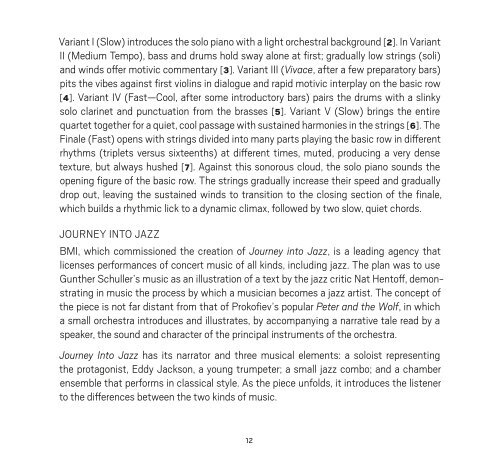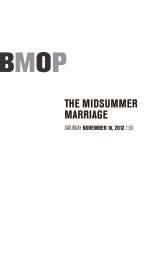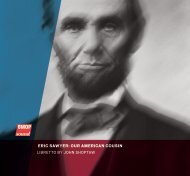gunther schuller: journey into jazz - Boston Modern Orchestra Project
gunther schuller: journey into jazz - Boston Modern Orchestra Project
gunther schuller: journey into jazz - Boston Modern Orchestra Project
Create successful ePaper yourself
Turn your PDF publications into a flip-book with our unique Google optimized e-Paper software.
Variant i (Slow) introduces the solo piano with a light orchestral background [2]. in Variant<br />
ii (Medium Tempo), bass and drums hold sway alone at first; gradually low strings (soli)<br />
and winds offer motivic commentary [3]. Variant iii (Vivace, after a few preparatory bars)<br />
pits the vibes against first violins in dialogue and rapid motivic interplay on the basic row<br />
[4]. Variant iV (fast—cool, after some introductory bars) pairs the drums with a slinky<br />
solo clarinet and punctuation from the brasses [5]. Variant V (Slow) brings the entire<br />
quartet together for a quiet, cool passage with sustained harmonies in the strings [6]. The<br />
finale (fast) opens with strings divided <strong>into</strong> many parts playing the basic row in different<br />
rhythms (triplets versus sixteenths) at different times, muted, producing a very dense<br />
texture, but always hushed [7]. against this sonorous cloud, the solo piano sounds the<br />
opening figure of the basic row. The strings gradually increase their speed and gradually<br />
drop out, leaving the sustained winds to transition to the closing section of the finale,<br />
which builds a rhythmic lick to a dynamic climax, followed by two slow, quiet chords.<br />
JouRnEy inTo Jazz<br />
BMi, which commissioned the creation of Journey <strong>into</strong> Jazz, is a leading agency that<br />
licenses performances of concert music of all kinds, including <strong>jazz</strong>. The plan was to use<br />
Gunther Schuller’s music as an illustration of a text by the <strong>jazz</strong> critic nat Hentoff, demonstrating<br />
in music the process by which a musician becomes a <strong>jazz</strong> artist. The concept of<br />
the piece is not far distant from that of Prokofiev’s popular Peter and the Wolf, in which<br />
a small orchestra introduces and illustrates, by accompanying a narrative tale read by a<br />
speaker, the sound and character of the principal instruments of the orchestra.<br />
Journey Into Jazz has its narrator and three musical elements: a soloist representing<br />
the protagonist, Eddy Jackson, a young trumpeter; a small <strong>jazz</strong> combo; and a chamber<br />
ensemble that performs in classical style. as the piece unfolds, it introduces the listener<br />
to the differences between the two kinds of music.<br />
concERTino foR Jazz quaRTET anD oRcHESTRa<br />
The opening movement (Slow) is consistently in 5/4 time—then quite unusual in <strong>jazz</strong>—<br />
and opens with a descending gesture spread through the strings [9]. after a few measures<br />
the flute, oboe, and horn join with sustained notes, and the <strong>jazz</strong> quartet makes its<br />
entrance. unlike the orchestra’s part, which is fully written out, the <strong>jazz</strong> quartet’s music is<br />
almost entirely notated in the manner of traditional <strong>jazz</strong> parts (except for brief passages<br />
where one or more of the instruments has a specifically notated part: each measure is<br />
marked by a series of slashes representing the number of beats in the measure, five for<br />
the opening movement), and an indication of the basic chord pattern for that bar. from<br />
this, and from what they hear around them, the <strong>jazz</strong> musicians mostly improvise their<br />
part. Meanwhile the orchestral players, whose parts are written out fully in traditional<br />
notation, find themselves confronted with rhythms, syncopations, accentuations, articulations,<br />
and lines that are generally characteristic of <strong>jazz</strong> and invite—even demand—the<br />
ability to swing: not simply to count beats and play at the proper time, but to do so with<br />
the freer feeling of <strong>jazz</strong>.<br />
for the blues-related second movement (though the basic pattern is one of thirteen,<br />
rather than twelve bars, as in the standard blues form), more of the part for the <strong>jazz</strong> quartet<br />
is actually written out in full [10]. Each thirteen-bar unit has its own character and<br />
color, as the orchestra slowly but noticeably grows in strength until it finally overpowers<br />
the quartet in the last variation. Then the orchestra gradually drops out so that the quartet<br />
has the final, quiet comment.<br />
The last movement begins at a somewhat faster tempo, but—most unusually for <strong>jazz</strong>—<br />
it then continues to move gradually faster and faster (the tempo marking accelerando<br />
sempre— “speeding up continually”) [11]. The accelerando is the characteristic element<br />
of this movement, bringing it to a close with a breathtaking rush.<br />
12 13<br />
© 2008 Steven ledbetter










